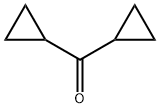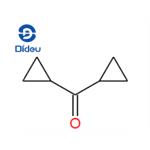Chemical Properties
clear colourless to yellowish liquid
Uses
Dicyclopropyl Ketone is used as a reagent in the synthesis of a new class of potent and selective agonists of dimeric carbamoylguanidine-type histamine H2 receptor ligands. Also used in the preparation of chemical space analogs of PNU-282,987 and SSR180711, which have nicotinic receptor activity.
Preparation
Preparation of Dicyclopropyl ketone
Reaction: To a one liter three-necked flask fitted with a reflux condenser and a metal Hershberg stirrer there was added 600 ml. of 20% sodium hydroxide and 165g . (0.9mole) of 1,7 -dichloro-4-heptanone. The mixture was refluxed for 30 minutes with vigorous stirring, then steam distilled until the characteristic odor of dicyclopropyl ketone was absent from the distillate. The distillate was then saturated with potassium carbonate, the upper layer separated and the water layer extracted once with ether. The combined organic layers were dried over potassium carbonate. after removal of the ether there was dist illed 69g. (70%) of dicyclopropyl ketone, b.p . 69° at 20 mm, nD25 1.4648-1.4654.
References
[1] G A Olah, G Liang, G K Prakash. “The unusual Favorskii-Nazarov reaction of dicyclopropyl ketone.” Proceedings of the National Academy of Sciences of the United States of America (1976): 2945–6.
[2] Gerd Schrumpf, Thomas Alshuth. “Conformational equilibrium of dicyclopropyl ketone.” Spectrochimica acta. Part A: Molecular spectroscopy 43 7 (1987): Pages 939-942.





